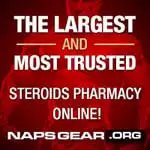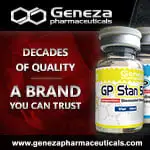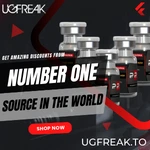Mavy said:
Damn ... good info 40! I really should get my father taking some of this (he has high blood pressure, and suffered a stroke last summer), he has got a complete re-vamp on his diet now ... which was the biggest part, (couldnt eat any meal without TUNS of salt ... I am serious). He is actually going to the gym now too which I am very surprised at.
Its funny because I was in at the plasma center a few weeks ago to give plasma, and while waiting, I saw an informational pamphlet that said Nattokinase on it. I had no idea what the hell it was so didnt bother to read it... wished I would have then, could have asked some people there about it.
Couple Qs for ya if you dont mind...
Is this stuff to just be used in place of the conventional clot-dissolving drugs like tissue plasminogen activators (TPAs)?
Also, ... would you say that this would have an effect/benefit directly on blood pressure, or just as a clot-dissolving agent only?Usually these two are so closely tied with one another anyways.
I am wondering if this would be something that would be good to take with a conventional 10-12 week cycle if blood pressure is a concern, or if it would be overkill because of the time frame.
I did not know you have been on for so long bro? Is that 20yrs straight? If so ... when and why did you decide to go the HRT route? If you dont mind me asking? Again ... good info bro.
Cheers,
Mavy
bro, please read the following excerpt from the link i have also provided below. yes, it will help some with blood pressure, however, i would avoid stopping any bp med's w/o a doc's okay and close monitiring of it. in the case of a cycle, where bp would be a concern, it's not nearly as effective as other drugs. for that reason i would not rely on it for that particular purpose (high bp). for clot busting and prevention, there is nothing else like it. as far as my test use, no, i haven't used continuously for 20 years, but i have been on test in some form or another for most of that period. my first use of test when i was 21 years old (i'll be 43 in 2 weeks) and that was pellets that were implanted under my skin on the top of my ass (by a doc). after that it was every type of application you can imagine: gel, injects, oral (methytest), lozenges, more implants, patches, and i think that's all. lol get your dad on nattokinase bro, you'll be helping him more than anything he's currently doing, seriously.
the following is pasted from the following link...
http://www.heart1.com/news/newsfeed.cfm/1553/1
... begin paste
Some of the endogenous and exogenous agents involved in clotting homeostasis are plasmin, heparin, coumarin/warfarin, and T-PA. However, these agents have limitations and/or serious side effects:
Plasmin is an endogenous protease that resembles trypsin (a digestive protease), and is the activated form of plasminogen. It is able to digest fibrin fibers; however, its limitation is that it is slowly activated and therefore slow to act. In addition, it works better to dissolve small clots, rather than larger ones.
Heparin is a drug given intravenously that acts as an anticoagulant by inhibiting thrombin. Heparin is often associated with side effects such as increased bleeding and hemorrhage.
Coumarin/Warfarin is a drug that works by competing with vitamin K for reactive sites in the enzymatic process for the formation of prothrombin and clotting factors, thereby blocking the clotting action of vitamin K.
Another drug used to manipulate the above process is TPA (tissue plasminogen activator), which is effective in activating plasminogen to plasmin. Although given as an intravenous drug, it is also a naturally occurring substance produced endogenously, although in much smaller amounts than that used as medical therapy.
Streptokinase is another enzyme derived from betahemolytic streptococci, and used as a medical therapy. In addition to the above-mentioned serious side effects and limitations, these medical therapies lack true utility in that to be therapeutic, they must be injected.
Oral enzymes continue to be studied as possible alternatives to the injectable varieties. Fibrinolytic therapy through the use of oral enzymes was investigated by Sumi and co-workers 10 years ago in an animal model. In that study, enteric-coated urokinase (UK) capsules were given to normal and experimental dogs with saphenous vein thrombosis. Previous findings indicated that intravenous (IV) administration did not show any clear thrombolytic effect, but that oral administration enhanced the fibrinolytic activity, serving as a treatment to lyse the thrombi in a mild but sustained way. This supported the idea that oral enzyme agents can and do have systemic fibrinolytic properties. The underlying mechanism of such fibrinolytic therapy by oral administration was then confirmed by basic research involving absorption of the administered UK across the intestinal tract, and by the release into the blood of endogenous plasminogen activator, which originated from the liver and/or endothelial cells. The enteric-coated UK capsules (60,000 U/ day for 7 days) also exhibited a clinical efficacy against cerebral thrombi. Even greater results were obtained in double-blind tests at multicenter trials employing a dose of 120,000 U/day for 7 days. [94,95]
Recently, a natural enzyme, potent in the oral form, has been discovered, researched, and found to be a most promising agent not only in reversing clots, but in preventing them and modulating the clotting process in ways that help reestablish homeostasis. This enzyme is called nattokinase, and has been called "the enzyme of enzymes" because it may serve as a non-specific activator of most endogenous enzymes (possibly by cleaving the CH3 terminus of zymogens [pre-made enzymes in their inactive form]).97 Nattokinase is a serine endopeptidase with a molecular weight of 20,000 Daltons and a point of ionization (pI) of 8.6. This isolated fibrinolytic enzyme, derived from a traditional Japanese food, natto, was discovered by Dr. Hiroyuki Sumi and resembles plasmin. Nattokinase (NK), an enzyme derived from natto-a popular fermented soybean food in Japan derived from vegetable cheese (boiled and fermented soybeans with a special bacterium, bacillus subtilisin natto) - shows potent fibrinolytic activity and was discovered by Dr. Sumi at the University of Chicago's medical school.98 Dr. Sumi was conducting research on some 200 kinds of foods from all over the world in search of a natural substance that could dissolve and even prevent blood clots. He found that natto had the highest fibrinolytic activity among all those foods tested, presenting the results of his research in Japan in 1986.
Natto has a long cultural history, extending back more than 1,000 years.' Traditionally, it was also used as a folk medicine for heart and vascular diseases, to relieve fatigue, and as an anti-beriberi agent. Dr. Sumi says nattokinase "shows a potency matched by no other enzyme."
Nattokinase is extremely stable under variations in temperature, and in both acid and alkali milieu. Currently, nattokinase has been the subject of 17 research studies, including two small human trials. In one such study, thrombi were induced in dogs, who were given either nattokinase or placebo. Angiogram confirmation showed that the dogs who received the enzyme regained normal circulation within five hours of treatment, whereas the placebo group continued to have demonstrable evidence of thrombus occlusion even after 18 hours." In another study in Japan to compare nattokinase's and plasmin's ability to dissolve thrombi in the carotid arteries of rats, animals treated with nattokinase regained 62 percent of their blood flow, whereas the animals treated with plasmin regained 15.8 percent of their blood flow.100 While the human body contains several enzymes that promote the creation of blood clots, it produces only one that can dissolve clots (plasmin), and the production of that enzyme diminishes as we age. It is interesting to note that oral nattokinase in this study was more effective than plasmin in dissolving thrombi. [94,95] Research indicates that the mechanisms of nattokinase stem from its close resemblance to endogenous plasmin. It appears to be able to dissolve fibrin directly, and it may enhance the body's own production of plasmin. Furthermore, nattokinase appears to have ACE (Angiotensin Converting Enzyme) inhibitor activity. In studies, it has been able to lower systolic blood pressure up to 11 percent and diastolic pressure up to 9.7 percent. [101]
Unlike antithrombin drugs that wear off shortly after IV treatment is discontinued, nattokinase produces prolonged action in two ways: it prevents coagulation of blood, and it dissolves existing thrombi. Both the efficacy and the prolonged action of NK can be determined by measuring levels of euglobulin fibrinolytic activity (EFA) and fibrin degradation products (FDP), which both become elevated as fibrin is being dissolved. By measuring EFA and FDP levels, the activity of NK has been determined to last from 8 to 12 hours. An additional parameter for confirming the action of NK following oral administration is a rise in blood levels of TPA antigen (tissue plasminogen activator), which indicates a release of TPA from the endothelial cells and/or the liver.
...
BY NICHOLAS CALVI,NO, DC, AND RALPH HOLSWORTH, DO
... end paste



 Please Scroll Down to See Forums Below
Please Scroll Down to See Forums Below 











 Damn is this a Public Service Announcemnet.......talk about your steroid abuse deterrents, pancreatites, HBP, low test and GH production, blood thicker than glue, tendons shot, and fucked up teeth..........whoa!!!!!!!!
Damn is this a Public Service Announcemnet.......talk about your steroid abuse deterrents, pancreatites, HBP, low test and GH production, blood thicker than glue, tendons shot, and fucked up teeth..........whoa!!!!!!!!